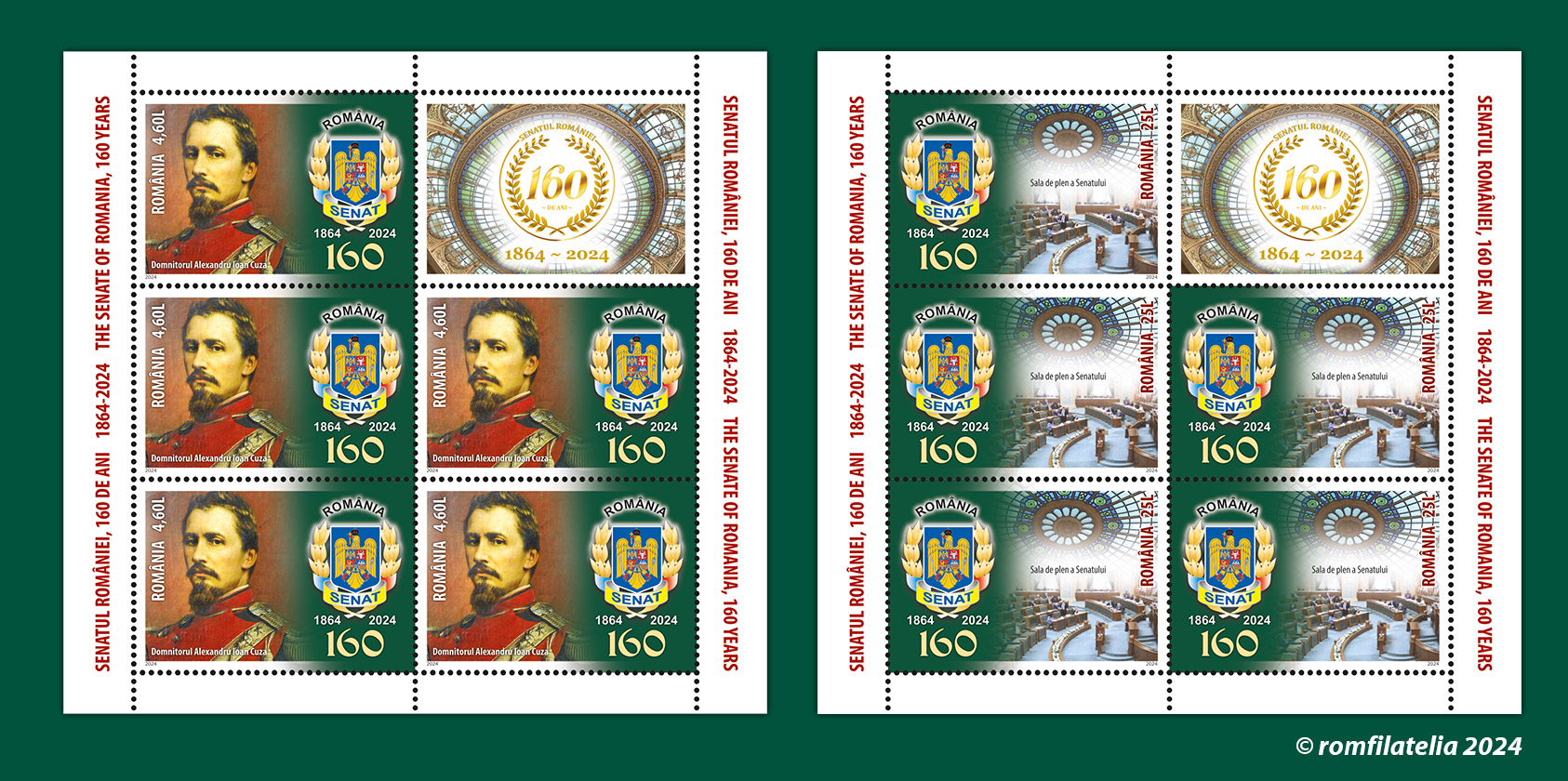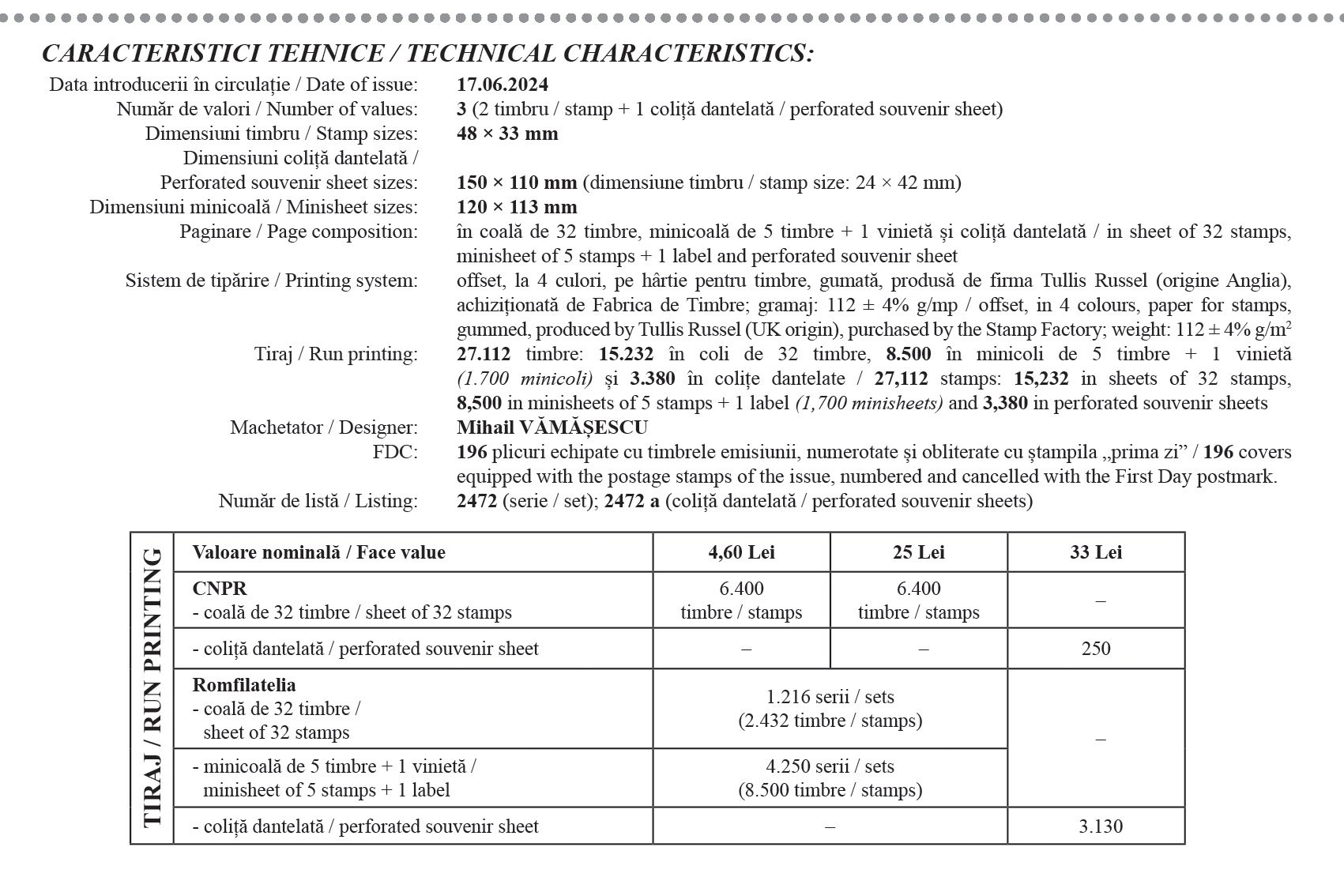 On the occasion of the 160th anniversary since the formal establishment of modern Romania’s fundamental institution, the Senate, which asserted oneself as an authoritative forum of parliamentary debate, contributing visibly to maintaining the balance between the political structures, to the defence of democratic rights and freedoms, and to promoting national ideals, Romfilatelia introduces into circulation, on Monday, June 17th, the issue of postage stamps dedicated to this event, entitled “The Senate of Romania, 160 years”.
On the occasion of the 160th anniversary since the formal establishment of modern Romania’s fundamental institution, the Senate, which asserted oneself as an authoritative forum of parliamentary debate, contributing visibly to maintaining the balance between the political structures, to the defence of democratic rights and freedoms, and to promoting national ideals, Romfilatelia introduces into circulation, on Monday, June 17th, the issue of postage stamps dedicated to this event, entitled “The Senate of Romania, 160 years”.
In 1859, the Union of the Romanian Principalities initiated the first actions aimed at the democratic reorganization of political and administrative structures within a state that wanted to join the modern states of Europe.
Alexandru Ioan Cuza and Mihail Kogălniceanu offered the Romanian national state a draft of laws, rules and political structures similar to democratic countries, which stood as examples of genuine democracies.
Through a document with constitutional value called ‘Developing Bylaw of the Paris Convention of August 7th/19th, 1858’, Alexandru Ioan Cuza provided for the establishment of a new parliamentary Chamber, alongside the Chamber of Deputies. Within this bicameral system, the first Senate of Romania had duties regarding the control of the constitutionality of laws, functioning as a ‘weighting body’ and as a balancing factor between the powers of the state. By the 1866 Constitution, the Senate became an elected body, based on census vote (voters had to have a certain annual income for which they paid a certain amount of tax). There were also some de jure members: the heir to the throne and the leaders of the church. The members of the Senate were elected two from each county, for a term of 8 years, and half of their number was renewed every 4 years.
After the achievement of the Great Union, the provisions of the 1923 Constitution facilitated the assertion of new social and political forces on the political scene. The interwar senate was made up of de jure senators (representatives of cults, people who held important political positions) and senators elected for a four-year term.
After a period of authoritarian monarchy (1938 and 1939) and the communist period when the Senate was abolished (replaced with a communist institution, i.e. the Great National Assembly), the Revolution of December 1989 reopened the way for Romania to return to an authentic democratic regime, based on free elections and political pluralism. Re-established in 1990 as a legislative and representative institution, the Romanian Senate has become a first-rate exponent of democratic and parliamentary traditions. Through the measures taken in 2003 regarding the establishment of a new operating mechanism of the bicameral system, a streamlining of the legislative activity and the elimination of mediation stages was ensured.
The anniversary stamp issue reflects the essence of the theme in the graphics of its components. The postage stamp with the face value of Lei 4.60 reproduces the portrait of Alexandru Ioan Cuza and the official coat of arms of the institution.
The postage stamp with the face value of Lei 25 reproduces a panoramic image of the Senate Plenary
Hall next to the official coat of arms of the institution. The rouletted postage stamp block, whose postage stamp has the face value of Lei 33, reproduces the vast panorama of the facade of the Romanian Senate headquarters under the image of the dome of the Plenary Hall. The First Day Cover of the issue brings together the premises of the Plenary Hall, the coat of arms of the Romanian Senate and the explanatory text, to promote the anniversary of the highest institution with legislative powers, the Romanian Senate.
Romfilatelia thanks the representatives of the Romanian Senate for their collaboration in the development of this postage stamps issue.



